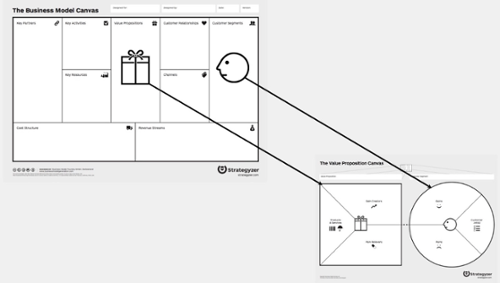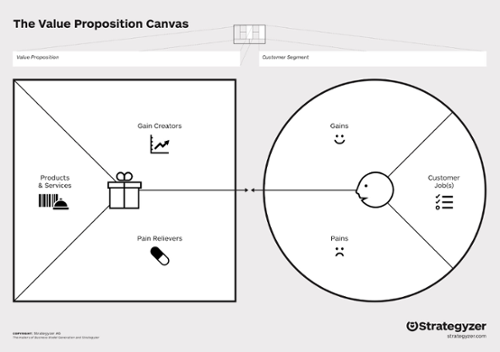What is a value proposition?
Many companies are clear about their promise to their customers; some even know why the client wants them since they maintain good communication with...
5 min read
Por Fernando Solano | Jul 26, 2019
Introduction to Value Proposition Canvas
Alexander Osterwalder (creator of the business models Canvas) developed a tool that facilitates the design of the value proposition focused on customers and their needs and customer requirements. The Value Proposition Canvas promotes teamwork, enabling the understanding of what added value is in the eyes of the client.
The Value Proposition Canvas helps organizations and teams systematically create solutions that fit the real needs of their customers. The tool is used before and during the development of deep client knowledge; since this framework allows us to collect, structure, and make the client's information tangible: their needs, requirements, joys, and frustrations. Before developing your value proposition (solution), highlight what you should learn from customers. Once you collect customer information, analyze and evaluate the adjustment of your solution to customer needs. This will allow you to save time since you have the input to develop products/services that customers want.

Generating Added Value
The Value Proposition Canvas is developed as a complement to the Business Model Canvas, which helps teams pay special attention to the main purpose of every business model: customers. Anyone can generate creative ideas, yet they might not satisfy their clients’ wants and needs. When using the Value Proposition Canvas, organizations can identify the needs of customers in a visual and structured way, since it allows them to identify, in a simple way, the requirements of the clients (their sources of pain or frustration and joy).
Joys and Sorrows
The Value Proposition Canvas helps us identify:
Obtaining Information from Customers
To obtain customer information we recommend doing an ethnographic study, which consists of talking to and observing customers. As you acquire the information, take notes and make categories of your notes. You will see how you’ll begin to have a complete picture of how to serve your customers in the best possible way (what we call fit or fit with the market). Remember that, as providers, it is important to solve the biggest pain customers have. When we are clear about what our customers want, we can know how to offer a value proposition that contains the most important elements for our customers.
Fit Solution - Market
It is important that there is a fit between the value proposition and the market. This is achieved with solutions that relieve pain and generate profits for our clients. The Value Proposition Canvas helps us minimize the chances of failure as it puts us in a position of advantage to develop a service that helps our customer segment. Remember that the fit is initially evaluated by us as a business, but that it is the customer who has the last word.
Test Your Value Proposition
Now that you have created a value proposition that looks promising, you should test it at an early stage so you can make adjustments on time. It may happen that the requirements of the clients on jobs, profits, and pains have been misunderstood. There could also be a problem with the assumptions made in the process. Therefore, the value proposition must be translated into practice. In a Value Proposition Canvas, it is important to always test the value proposition together with the customer so that it can be established if the proposal adds value to the customer. The client is guided through a step-by-step process to assess whether these assumptions and interpretations are correct. After all, it is the customer who determines whether the value proposition will produce results for him/her or not.


Many companies are clear about their promise to their customers; some even know why the client wants them since they maintain good communication with...

A value proposition is an essential element in any business plan. It describes what makes our product or service different from the competition and...

If you have ever googled "business model", "value proposition" or similar terms, you will have come across Strategyzer. Strategyzer is a strategy and...